-----------------
Research Themes
-----------------
Publications
-----------------
Teaching
-----------------
|
![]() |
WAYNE H. POLLARD
Professor
Department of Geography
McGill University
805 Sherbrooke St. West
Montreal, Quebec, CANADA,
514 398‑4454/7437 (phone/fax)
Email
|
|
EDUCATION:
Ph.D. 1983 University of Ottawa, Department of Geography.
M.Sc. 1979 University of Guelph, Geography Department and the Centre for Resources Development.
B.Sc. Honours 1975 University of Guelph, Geography and Geology.
POSITIONS HELD:
| 2010 - pres |
Professor, Department of Geography, McGill University |
| 1993-2009 |
Associate Professor, Geography, McGill University |
| 2000-pres |
Associate Member of the McGill School of the Environment |
| 2003-2005 |
Director, McGill Centre for Climate and Global Change Research (C2GCR) FCAR funded research centre |
| 1990-pres. |
Research Director of both the McGill Subarctic Research Station (MSARS) in Schefferville, Quebec and the McGill High Arctic Research Stations (MARS) on Axel Heiberg Island, Nunavut |
| 1988-1993 |
Assistant Professor, Geography, McGill University |
| 1986-1988 |
Assistant Professor, Geography, Memorial University of Newfoundland |
| 1984-1986 |
NSERC Post Doctoral Fellow- Visiting Scientist in a Canadian Government Laboratory Program, Earth Physics Branch, Energy, Mines and Resources, Ottawa |
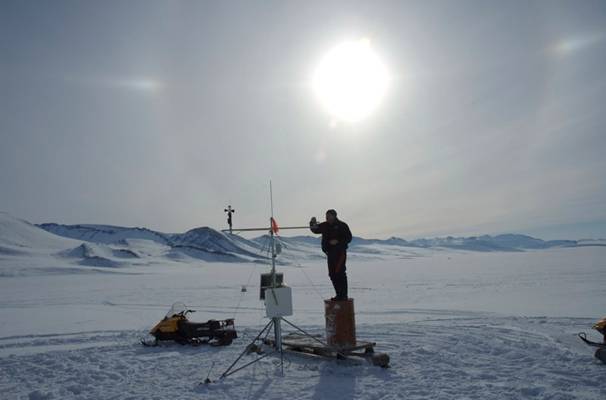
Research Statement:
“The pursuit of truth and beauty is a sphere of activity in which we are permitted to remain children all our lives.” Albert Einstein
Extreme environments like the Arctic and Antarctic are important scientific frontiers that help define the limits of Earth’s physical and biological processes. In particular extreme cold temperatures and the general lack of liquid water create a system where mechanical processes predominate and biological and chemical processes are confined to niche environments or are limited to brief periods when small amounts of water are available. The limiting nature of these environments reduce biophysical complexity thereby readily allowing the integrated investigation of climatic, geologic/geomorphic and biologic systems in a true Earth System Science framework. Arctic and Antarctic environments have many physical similarities, including seasonal patterns of daylight and temperature, the pervasive occurrence of glaciers, ice sheets and permafrost, and the strong environmental control on biological systems. However, the geographic position of the Antarctic continent, the vast extent of the East and West Antarctic Ice Sheets and the small isolated nature of ice-free areas (<2% of the landscape) tend to amplify many of the environmental extremes. The extreme cold and hyper-arid conditions of Antarctica and the high Arctic provide insight into conditions that may have existed on Mars 2-3 billion years ago (and to a lesser degree today) and thus are useful analogues in our search for evidence of Martian life.
My research centers upon the field investigation of water and ice in cold polar desert environments. My long-term goals are to understand and explain the hydrological and physical processes that shape and define cold dry landscapes and to identify niche environments in permafrost that are capable of harboring microbial life at or near the limit of its habitability. My research ranges from the field observation and measurement of natural processes at the landform and landscape scales to the microscopic examination of soil pores, ice crystals and intra crystalline brine films. My work incorporates a combination of traditional geologic, hydrogeologic, geomorphic and stratigraphic field approaches together with precision instrumentation to measure and map climatologic, hydrologic and geomorphic processes and patterns and microbial habitats. Laboratory and statistical analyses together with numerical modeling are undertaken to test and verify hypotheses.
Central to my research are: (a) the investigation of the dynamic interaction between water and cryotic ground, (b) the formation and degradation of surface and subsurface ice and (c) the interpretation of the environmental significance of landforms related to permafrost, ground ice and ground water. Over the last 6-7 years my science has evolved by focusing on progressively more complex questions and looking at progressively more extreme environments (the Arctic, Antarctica and Mars). The following are the projects in which I am currently active
RESEARCH THEMES
My research group is currently involved in a series of projects focusing on various biophysical aspects of geocryology, including:
1) Ground ice in a changing climates
This research looks at the nature and distribution of ground ice and its role in landscape development. Initially this work looked at the Holocene evolution of high Arctic permafrost and ground ice (including its palaeoenvironmental significance) and the role of ground ice in contemporary landform development. My early research pioneered the application of petrographic techniques to the identification ground ice origin. Recently the focus of this research has expanded to include the potential impact of climate change on ice-rich landscapes. Climate change will present enormous challenges in polar regions. Assuming that global change has begun and GCM predictions are realistic, then the following questions pertaining to polar landscapes need to be addressed. First, “How sensitive are polar landscapes to climate change and how will ice-rich permafrost systems respond as climates warm?” and second “are polar landscapes already displaying the affects of climate change and how do we distinguish them from normal variation?” With these questions in mind, the primary focus of my research is the detection and analysis of climate change impacts on (1) high latitude polar desert systems with an emphasis on permafrost dynamics and surface hydrology (study area Ellesmere Island) and (2) ice-rich coastal landscapes of the southern Beaufort Sea. The overarching goal of the proposed study is to determine how high Arctic permafrost will respond to climate change.
I began research on massive ground ice in the McMurdo Dry Valley area of Antarctica in 1997 and includes 2 field seasons in the McMurdo Dry Valleys. The first season I worked with the US Antarctic Program based at the LTER site on Lake Hoare in the Taylor Valley. Using ground penetrating radar I began mapping ground ice conditions in several of the dry valleys. In 2000 and 2003 I was part of the New Zealand Antarctic Program involved in a permafrost drilling project in the Allan Hills area. In addition to characterising ground ice type and distribution, I have also been investigating sublimation/desiccation processes in areas underlain by massive ice.
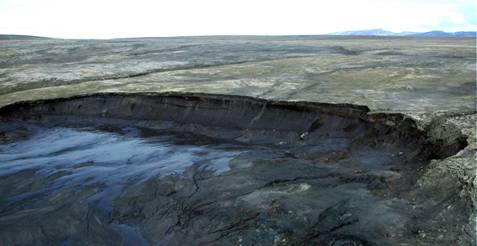

2) Groundwater permafrost interactions
There is limited information on saturated groundwater flow in permafrost, particularly in the High Arctic. It is generally assumed that thick permafrost, common in the Arctic Islands, provides an effective aquitard preventing groundwater discharge and resulting in the separation of groundwater into sub-, intra-, and suprapermafrost systems. Accordingly perennial springs are generally thought to be absent in this environment. I have confirmed 8 groups of highly mineralized, cold, perennial springs on Axel Heiberg Island in the Canadian High Arctic. The occurrence of perennial spring activity together with discharge-related phenomena like travertines, salt tuffas, fresh and brine icings, and frost mounds raise a number of interesting questions about the unique nature of the geologic, geocryologic, hydrologic, and biologic conditions of this area. For example, What is the geologic setting of these springs? How do they interact with the deep permafrost known to exist in the High Arctic? How does the cold climate affect surface hydrologic processes? How does the year-round availability of water affect the surrounding polar desert system? These questions form the basis of my research. In recent years several themes have emerged, including: (1) the study of high Arctic spring hydrogeology and geochemistry to assess the origin and age of groundwater, (2) the study of surface flow and metastable mineralization under extreme cold temperatures, (3) the physical and chemical dynamics of icing and frost mound formation, (4) and high Arctic springs as analogues for ancient groundwater systems on Mars.
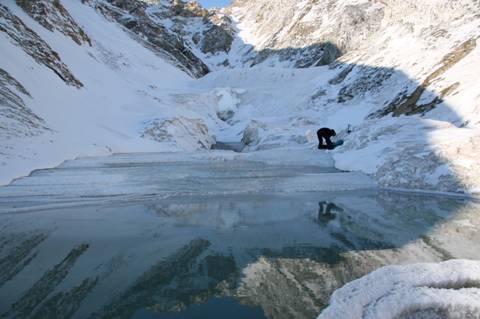
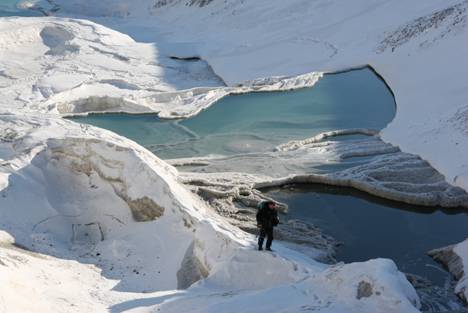
3) Polar environments as planetary analogues
Through collaborations with NASA and CSA an important part of our research is the application of various permafrost and hydrologic systems as analogues for similar systems on Mars and the moons of Saturn and Jupiter. The Canadian Space Agency has funded the construction of a Canadian Analogue Research Network (CARN) site at the McGill Arctic Research Station (MARS) on Axel Heiberg Island. In this regard systems like the perennial springs, ice wedge polygons, massive ground ice, crytoendoliths …. are being studied under CSA’s CARN program to assess their relevance to space exploration and astrobiology.
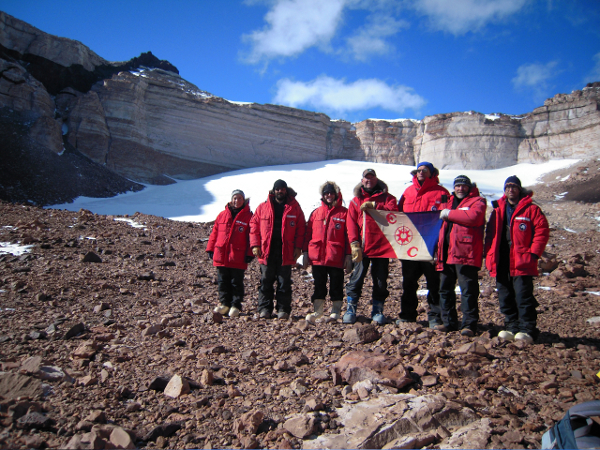
4) Life in extreme environments
Since 2003 I have been working in collaboration with Dr. Lyle Whyte (Department of Renewable Resources) on the microbial ecology of permafrost and ground ice. This research involves the characterization of microbial communities and the limits of their occurrence in permafrost samples and cores. This research also involves the use of fluorescent microspheres to assess patters of sample contamination during coring and sample handling. A second component of this theme involves collaboration with Dr. Chris Omelon (University of Texas) and Dr. Grant Ferris (University of Toronto) to analyse crytoendoliths in sandstones in the high Arctic. My role in this research is to characterize the microhabitat of both permafrost soils and porous sandstones

5) Permafrost analysis – Technology
This research involves the application and development of subsurface exploration technologies to assess the nature and distribution of ground ice and groundwater in permafrost. At the heart of this research are various complementary geophysical techniques, including ground penetrating radar and capacitively coupled resistivity as well as permafrost coring. Initially developed as part of projects 1 & 2 above, this research has taken on a strong space exploration orientation and is now closely linked to project 3. We are currently involved in several “proof of concept” projects concerned with both geophysical mapping and coring on Mars.


PUBLICATIONS (SINCE 2005)
Refereed journal papers (* denotes student or pdf)
- Heldmann, J., Marinova M., Williams, K. Lacelle, D., McKay, D., Davila, A., Pollard, W. & Andersen, D. (in press – accepted 10/10/11). Formation and Evolution of Buried Snowpack Deposits in Pearse Valley, Antarctica and Implications for Mars. Antarctic Science.
- Lantuit, H.; Pollard, W.H.; Couture, N.; Fritz, M.; Schirmeister, L.; Meyer, H. and Hubberten, H. –W. (in press) Modern and Late Holocene retrogressive thaw slump activity on the Yukon Coastal Plain and Herschel Island, Yukon Territory, Canada, Permafrost and Periglacial Processes (accepted 02/2011)
- Fritz, M., Wetterich, S., Schirrmeister, L., Meyer, H., Lantuit, H. and Pollard, W.H. (2012). Eastern Beringia and beyond: Late Wisconsinan and Holocene landscape dynamics along the Yukon Coastal Plain, Canada. Palaeogeography, Palaeoclimatology, Palaeoecology. doi:10,1016/j.paleo.2011.12.015 18 p.
- Short N., Brisco, B., Couture, N., Pollard, W., Murnaghan, K. and Budkewitsch, P (2011) A comparison of TerraSAR-X and ALOS-PALSAR interferometry for monitoring permafrost environments, case study from Herschel Island, Canada. Remote Sensing of Environment. Doi:10.1016/j.rse.2011.08.012
- Lantuit, H., Overdun, P., Couture, N., Are, F., Atkinson, D., Brown, J., Cherkashov, G., Drozdov, D., Forbes, D., Graves-Gaylord, A., Grigoriev, M., Hubberten, H. -W., Jordan, J., Jorgenson, T., Ødegård, R. S., Ogorodov, S., Pollard, W., Rachold, V., Sedenko, S., Solomon, S., Steenhuisen, F., Streletskaya, I., Vasiliev, A., Wetterich, S. (2011). The ACD coastal database. A new classification scheme and statistics on arctic permafrost coastlines, Estuaries and Coasts. DOI 10.1007/s12237-010-9262-6
- Fritz, M., Wetterich, S., Meyer, H., Schirrmeister, L., Lantuit, H., and Pollard, W., (2011) Origin and characteristics of massive ground ice on Herschel Island (western Canadian Arctic) as revealed by stable water isotope and Hydrochemical signatures. Permafrost and Periglacial Processes, DOI: 10.1002/ppp.714
- Lacelle, D., Davilla, A., Pollard, W., Andersen, D., Heldmann, J., Marinova, M. and McKay, C. (2011) Stability of massive ground ice bodies in University Valley, McMurdo Dry Valleys of Antarctica: Using stable O–H isotope as tracers of sublimation in hyper-arid regions. Earth and Planetary Science Letters, 301 403-411
- *Niederberger, T., *Perreault, N., Stephanie, T., Sherwood Lollar, B., Lacrampe-Couloume, G., Andersen, D., Greer, C., Pollard, W., and Whyte, L. (2010) Microbial characterization of a subzero, hypersaline methane seep in the Canadian High Arctic. The ISME Journal, 4, 1326-1339 (October 2010) | doi:10.1038/ismej.2010.57
- *Haltigin T., Pollard W., and Dutilleul P. (2010) Comparison of ground and aerial-based approaches for quantifying polygonal terrain network geometry on Earth and Mars via spatial point pattern analysis. Planetary and Space Science 58, 1636-1649, doi: 10.1016/j.pss.2010.08.008
- *Hoque, Md. A, and Pollard, W.H (2009). Arctic coastal retreat through block failure Canadian Geotechnical Journal 46(10): 1103–1115
- * Lantuit, H., Rachold, V., Pollard, W.H., Steenhuisen, F., Ødegård, R., Hubberten, H.-W . (2009). Towards a calculation of organic carbon release from erosion of Arctic coasts using non-fractal coastline datasets, Marine Geology, 257(1-4), 1-10
- Pollard, W., *Tim Haltigin, T., Whyte, L., *Niederberger, T., Andersen, D., Omelon, C., Nadeau, J., Ecclestone, M., and Lebeuf, M. (2009). Analogue science activities at the McGill Arctic Research Station, Axel Heiberg Island, Canadian High Arctic. Journal of Planetary and Space Science, 57. 646-659.
- Dutilleul, P., *Haltigin, T.W., and Pollard, W.H. (2009). Analysis of polygonal terrain landforms on Earth and Mars through spatial point patterns. Environmetrics 20(2), 206-220.
- Coustenis, A. et al. (2009) ( Authorship includes the entire Tandem Mission Team including W. Pollard and T. Haltigin). TandEM: Titan and Enceladus Mission. Experimental Astronomy. 23 (3) , 893-946
- *Steven B, Pollard, W.H. Greer, C.W. and Whyte, L.G. (2008). Microbial diversity and activity through a permafrost/ground ice core profile from the Canadian high Arctic. Environmental Microbiology 10 (12) 3388-3403
- *Lantuit, H. and Pollard, W.H. (2008) Fifty years of coastal erosion and retrogressive thaw slump activity on Herschel Island, southern Beaufort Sea, Yukon Territory, Canada. Geomorphology 95, 84-102.
- *De Pascale, G., Pollard, W.H. and Williams, K., (2008). Geophysical mapping of ground ice using a combination of capacitive coupled resistivity and ground penetrating radar, NWT, Canada. Journal of Geophysical Research: 113, F02S90, doi:10.1029/2007JF000585,
- *Couture, N.J., and Pollard, W.H. (2007). Modelling geomorphic response to climatic change. Climatic Change, 85: 407-431. DOI 10.1007/s10584-007-9309-5.
- *Antoniades, D., Crawley, C, Douglas, M., Pienitz, R, Andersen, D., Doran, P., Hawes, I., Pollard, W., and Vincent, W. (2007). Abrupt environmental change in Canada’s northernmost lake inferred from diatom and fossil pigment stratigraphy. Geophysical Research Letters, 34, doi10.1029/2007 GL030.
- *Perreault, N., Andersen, D.T., Pollard, W.H., Greer, C.W. and Whyte, L.G. (2007). Culture independent analyses of microbial biodiversity in cold saline perennial springs in the Canadian High Arctic. Applied Environmental Microbiology,73, 5, 1532-1543
- *Steven, B., Briggs, G.; McKay, C., Pollard, W., Greer, C. and Whyte, L. (2007). Characterization of the microbial diversity in a permafrost sample from the Canadian Arctic using culture-dependent and culture-independent methods. Microbiology Ecology, 59, 513-523.
- *Omelon, C.R., Pollard, W.H., and Ferris, F.G (2007). Inorganic species distribution and microbial diversity within high Arctic cryptoendolithic habitats. Microbial Ecology, 54, 740-752.
- *Omelon, C.R., Pollard, W.H., and Ferris, F.G (2006a). Chemical and ultrastructural characterization of high Arctic cryptoendolithic habitats. Geomicrobiology Journal, 23, 189-20.
- *Omelon, C.R., Pollard, W.H., and Ferris, F.G (2006b). Environmental controls on microbial colonization of high Arctic cryptoendolithic habitats. Polar Biology. DOI 10.1007/s00300-006-0155-0, 11 journal pages.
- *Omelon, C.R., Pollard, W.H. and Andersen, D., (2006). Geochemical evolution of perennial springs and the formation of travertines at Expedition Fiord in the Canadian High Arctic. Applied Geochemistry, 21, 1-15
- *Steven, B., *Leveille, R., Pollard, W.H. and Whyte, L.G. (2006). Microbial Ecology and Biodiversity of Permafrost. Extremophiles ISSN: 1431-0651 (Paper) 1433-4909 (Online) DOI: 10.1007/s00792-006-0506-3
- Pollard, W.H. (2005). Icing processes associated with high arctic perennial springs on Axel Heiberg Island, Nunavut. Permafrost and Periglacial Processes, 16, 51-68.
- *Andersen, D., Pollard, W., McKay, C. and *Heldmann, J., (2005). Correction to “Cold springs in Permafrost on Earth and Mars”. Journal of Geophysical Research, 110, E04007.10.1029/2004JE002384
- Juck, D., *Whissel, G.,* Steven, B., Pollard, W., McKay, C., Greer, C. and Whyte, L. (2005). Utilization of Fluorescent Microspheres and a Green Fluorescent Protein-Marked Strain for Assessment of Microbiological Contamination of Permafrost and Ground Ice Core Samples from the Canadian High Arctic. Applied and Environmental Microbiology, 71, 1035-41.
- *Heldmann, J., McKay, C., Pollard, W. *Andersen, D. (2005). High Arctic saline icing dynamics. Arctic and Alpine Research, 37, 1, 127-135
- *Heldmann, J., Toon, B., Pollard, W., Mellon, M., Pitlick, J., McKay, C., and Andersen, D. (2005). Formation of Martian gullies by the flow of simultaneously freezing and boiling liquid water. Journal of Geophysical Research, 110. E05004 10.1029/2004JE002261
- *Lantuit, H. and Pollard, W.H. (2005) Temporal stereophotogrammetric analysis of retrogressive thaw slumps on Herschel Island, Yukon Territory. Natural Hazards and Earth System Science. 5, 413-423.
- *Lantuit, H., *Couture, N., Pollard, W.H., *Haltigin, T., *De Pascale, G. and Budkewitsch, P., (2005) "Short-term evolution of coastal polycyclic retrogressive thaw slumps on Herschel Island, Yukon Territory" Berichte zur Polar- und Meeresforschung, 506, 72-76.
- Murton, J.B., Whiteman, C.A., Waller, R.I., Pollard, W.H., Dallimore, S.R. & Clark, I., (2005) Basal ice facies and supraglacial melt-out till of the Laurentide Ice Sheet, Tuktoyaktuk Coastlands, western Arctic Canada. . Quaternary Science Reviews, 24, 681-705.
Refereed Conference Proceedings
- * Angelopoulos, *M., Fox, D. and Pollard, W.H. (in press – accepted 04/02/2012) Geochemically-Induced Unfrozen Water Effects on CCR Surveys of Massive Ground Ice, Western Canadian Arctic. Proceedings, Tenth International Conference on Permafrost. Salekhard, Yamal-Nenets autonomous district, Russia on June 25—29, 2012.
- * Sloan, H. and Pollard, W.H. (in press, accepted 04/02/2012) Vegetation Patterns of Stabilized Retrogressive Thaw Slumps, Herschel Island, Northern Yukon. Proceedings, Tenth International Conference on Permafrost. Salekhard, Yamal-Nenets autonomous district, Russia on June 25—29, 2012.
- Pollard, W.H., Lacelle, D., Davila, A. F., Andersen, D., McKay, C.P., Marinova, M. and Heldmann, J. (in press, accepted 04/02/2012) Ground Ice Conditions in University Valley, McMurdo Dry Valleys, Antarctica. Proceedings, Tenth International Conference on Permafrost. Salekhard, Yamal-Nenets autonomous district, Russia on June 25—29, 2012.
- *Angelopoulos, M.C., Pollard, W.H., and Couture, N.J. 2010. Integrated geophysical approach for the detection and assessment of ground ice at Parsons Lake, Northwest Territories. In: Proceedings, 63rd Canadian Geotechnical Conference and 6th Canadian Permafrost Conference, 12-16 September 2010, Calgary, Alberta, Canada. 1345-1352
- Pollard, W.H., and *Couture, N., (2008). Massive Ground Ice in the Eureka Sound Lowlands, Canadian High Arctic. Proceedings of the Ninth International Conference on Permafrost. 1433-1438
- *Couture, N., Hoque, Md. and Pollard, W.H. (2008). Modeling the erosion of ice-rich deposits along the Yukon Coastal Plain. Proceedings of the Ninth International Conference on Permafrost. 303-308
- *Hoque, Md. A. and Pollard, W.H. (2008). Thermal and mechanical Erosion along ice-rich arctic coasts. Proceedings of the Ninth International Conference on Permafrost. 741-746
- *De Pascale, G. and Pollard, W.H. (2008). Geophysical mapping of ground ice in the western Canadian Arctic. Proceedings of the Ninth International Conference on Permafrost. 337-342.
- *Grom, J.J. and Pollard, W.H. (2008). A study of high Arctic retrogressive thaw slump dynamics, Eureka Sound Lowlands, Ellesmere Island. Proceedings of the Ninth International Conference on Permafrost. 545-550.
- Andersen, D., Pollard, W.H. and McKay, C. (2008). The Perennial Springs of Axel Heiberg Island as an Analogue for Groundwater Discharge on Mars. Proceedings of the Ninth International Conference on Permafrost. 43-48
- Omelon, C., Pollard, W.H., Ferris, F.G. and P.C. Bennet (2008). Cyanobacteria within cryptoendolithic habitats: the role of high pH in biogenic rock weathering in the Canadian High Arctic. Proceedings of the Ninth International Conference on Permafrost. 1327-1332
- *Haltigin, T., Pollard, W.H., Ozinski, G., Duteulle, P. and Seaquist, J.W. (2008). Spatial analysis of small-scale polygonal terrain in Utopia Planitia, Mars: a comparison with terrestrial analogues. Proceedings of the Ninth International Conference on Permafrost. 639-644
- *Hoque, M.D. and Pollard, W.H. (2005) Block failure of arctic coastal cliffs under the influence of wave-cut notches. Proceedings of the Canadian Coastal Conference, edited byG. Manson G. Dartmouth Nova Scotia , 100-109
Refereed contributions and book chapters
- Pollard W (2010) Northern Canada. In Eric Bird (ed) Encyclopaedia of World's Coastal Landforms, Springer Science + Business Media B.V., Dordrecht. 169-177
- Pollard, W.H. (2005) Axel Heiberg Island. InEncyclopaedia of the Arctic. Edited by M. Nuttall, Fitsroy Dearborn Publishing Company, London, 181-182.
- Pollard, W.H. (2005) Herschel Island. InEncyclopaedia of the Arctic. Edited by M. Nuttall, Fitsroy Dearborn Publishing Company, London, 860-861.
- Pollard, W.H. (2005) Polar Deserts. InEncyclopaedia of the Arctic. Edited by M. Nuttall, Fitsroy Dearborn Publishing Company, London, 1659-1661.
- Pollard, W.H. (2005) Polygons. InEncyclopaedia of the Arctic. Edited by M. Nuttall, Fitsroy Dearborn Publishing Company, London, 1596-1598
- Pollard, W.H. (2005) Periglacial environments. InEncyclopaedia of the Arctic. Edited by M. Nuttall, Fitsroy Dearborn Publishing Company, London, 1609-1611.
- Pollard, W.H. (2005) Thermokarst. In Encyclopaedia of the Arctic. Edited by M. Nuttall, Fitsroy Dearborn Publishing Company, London, 2021-2023.
Invited and Keynote Lectures*
- “The nature and stability of ground ice: a bipolar comparison”. (Invited talk) IPY 2012: From Knowledge to Action. Session 1.2.4 - Permafrost on a Warming Planet. 04/12
- “Mars on Earth: Polar environments as planetary analogues” (Invited talk) McGill Space Day 03/12,
- “Exploring Mars on Earth: The Arctic as an analogue for Mars. McGill Mini Science Lecture Series: To Infinity and Beyond: Space Stars and the Universe. 05/09
-
Frozen fascination: adventures in permafrost. Polar Continental Shelf 50th Anniversary Celebration. Museum of Man, Ottawa. 05/08.
- *The effects of climate change on polar landscapes. SCAR-IASC Science Conference St. Petersburg, Russia. Invited Keynote lecture. 07/08
- Permafrost investigations in the Canadian Arctic. Alfred Wegener Institute Invited speaker series. 11/08.
- “Vulnerability of ice-rich coasts”. Yukon North Slope Conference, Whitehorse,01/07
- “Block failure along permafrost coasts”, AGU Annual Fall Meeting, San Francisco, 12/04
- “Icing processes associated with high arctic perennial springs, Axel Heiberg Island” Special Session for H.M. French, Canadian Geomorphology Research Group and l’Association Québécoise pour l’Étude du Quaternaire, Laval University, St. Foy, Quebec. 08/04
- “Canadian Antarctic research activities” Canadian National CliC Workshop – Victoria, 12/02
- “Hydrological research in the Antarctic” IPA Southern Hemisphere Working Group. International Conference on Permafrost, Southern Hemisphere Working Group, Zurich, 06/03
- “Polar regions as analogues for Mars” McGill Astrobiology Public Lecture, 02/01
Other Activities
International and National Committees
Member, Joint IASC/SCAR Bipolar Action Group (BipAG) 2007-2011
Chair, Canadian (National) Committee for Antarctic Research, 2001-2009.
Member, Canadian Committee for Antarctic Research, 1998 – 2009.
Canadian Representative on SCAR Geoscience Standing Science Group, 1998-2011.
Chair, SCAR GSSG Permafrost Action Group from 2002-2005
Chair, Polar Continental Shelf Program (PCSP) advisory committee 2003 – 2007.
Memeber, Polar Continental Shelf Program (PCSP) advisory committee 2011-pres
Chair, Polar Continental Shelf Program (PCSP), Science Screening Committee, 1999-2004
Member, Minister's National Advisory Board on Earth Sciences 2003 - 2007
Member, National IPY Committee 2004–06, re-appointed until 2008
Member, Canadian IPY Subcommittee on Logistics, Infrastructure and Emergency Preparedness (2005-2008)
Member, International Conference on Arctic Research Planning (ICAPII) Coastal Erosion Working Group 2004-2009.
Member, Canadian Space Agency’s Space Exploration Advisory Committee, 2001-06
Member, International Permafrost Association Astrobiology Working Group 2003-pres
Elected Fellow of the Arctic Institute of North America (2001)
Association of Canadian Universities for Northern Studies (ACUNS), Board of Directors 1998-2003
McGill University
Scientific Director- McGill’s Northern Field Stations (Schefferville/Axel Heiberg) 1992- pres
Director - McGill Centre for Climate and Global Change Research (C2GCR) 2002-2005
Member of the Global Environmental and Climate Change Centre (GEC3) 2005-pres
Chairman - McGill University Northern Scientific Training Program Committee, 1991-2003.
Member Department of Geography Graduate Affairs Committee, 2003-2006
Member Department of Geography Chair’s Advisory Committee , 2002-2005
Member Department of Geography Space and materials Committee 2003-pres.
Chair Department of Geography Undergraduate Affairs Committee 1993-1997
Geography Member of Faculty of Science Academic Affairs Committee 1993-1997
Recent Media Activities
“Quirks and Quarks” CBC Radio – State of Arctic Coasts
“The National” CBC Television – Interview on Antarctic Science
“The Current” CBC Radio Interview on Arctic climate change
“Discovery Channel” program on life in extreme environments
“Zone Science “– TV5 – interview on “Extreme Environments”
“White Frontier” French documentary on Arctic science
“Cross Canada” CBC Interview on Climate Change
”CBC North Radio – Whitehorse, Yellowknife and Iqaluit” 10+ Interviews concerning Arctic climate change, Permafrost and Arctic coasts”
Washington Post Interview – “Climate change impact on Inuit burial sites”
Ottawa Citizen Interview on Mars analogue research
Nunatsiaq News 3 Interviews on melting permafrost and climate change
Teaching:
Courses taught presently :
GEOG272: Earth Surface Processes
GEOG290: Local Field Excursion
GEOG495: Local Field Course
GEOG499: Subarctic Field Studies
GEOG536; Geocryology
Also
Honours research (GEOG491 & 492) ~ 1-2/yr
Independent studies (GEOG490) ~1-2/yr
Over the past 10 years I have also provided courses for the Nunavut Arctic College Teacher Education Program (NTEP), delivered science camps for Inuit high school students, Inuit teacher workshops on Science, and contributed to a Students on Ice expedition to Antarctica and a NASA Spaceward Bound expedition to the Arctic.
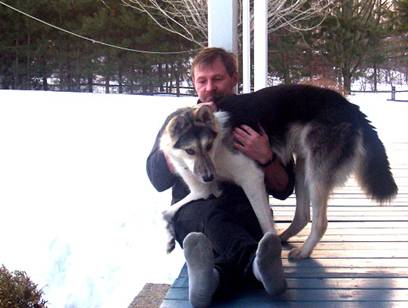
|

